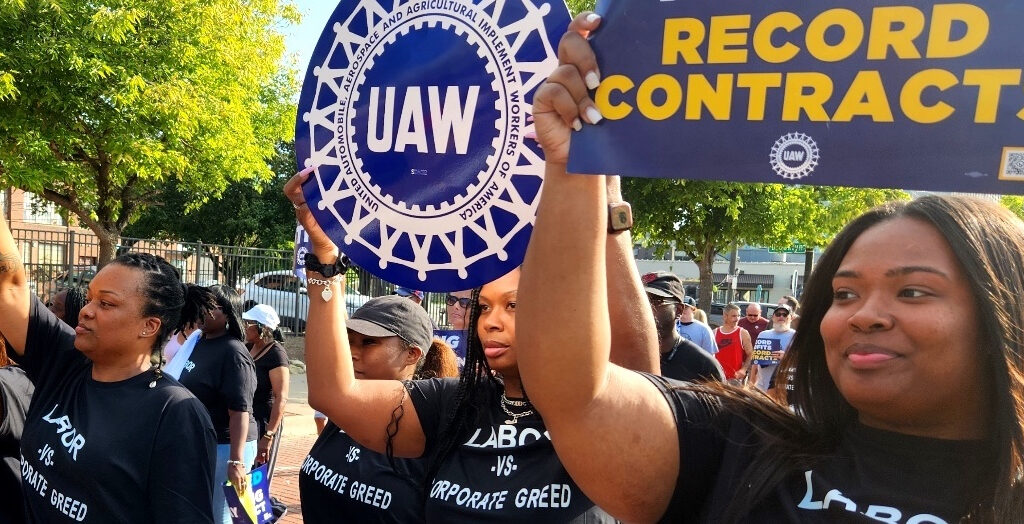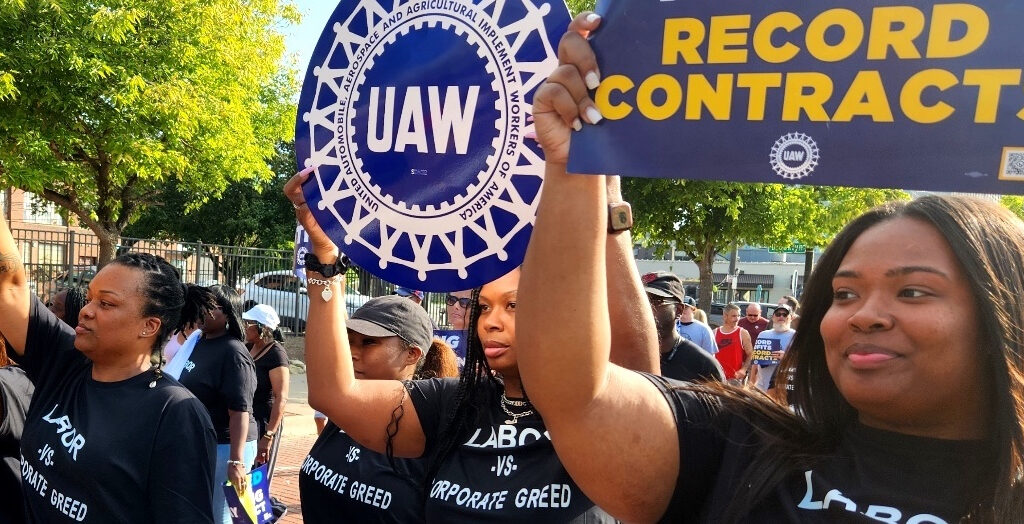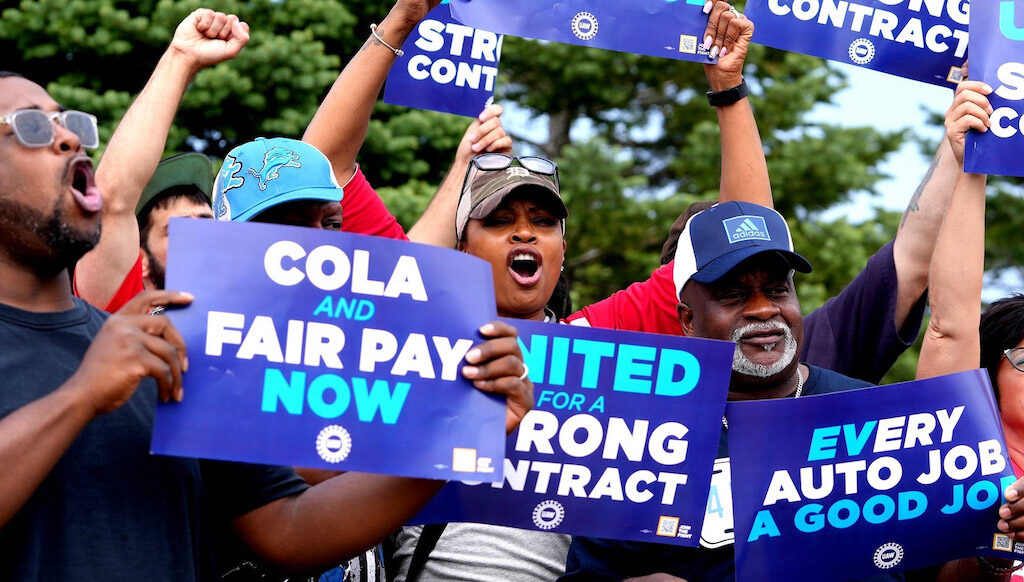
I’m not in a Union. What Can I do?
May Day 2028 is an enormous effort by workers all across the labor movement to align their contracts to expire together, forcing the hands of management to agree to some major concessions. Union workers know their power is in credible threats to withhold their labor, and they’re ready to show it.
However, only about 11 out of every 100 workers in the US are in a union. That means a small but significant number of workers are able to align their contracts. What about the majority of workers who aren’t in a union?

What is a union?
A union is a group of workers who organize together for better working conditions, also known as collective bargaining. By identifying what matters most among themselves, workers can make demands on their bosses together, demonstrating their strength and unity with a single voice.
Often, management will resist these demands, especially when it affects their profits, so they’ll try all manner of means to break up this union: punishing workers who organize, spreading fear and intimidation around the workplace, hiring lawyers and other consultants to pressure workers to stop organizing, and other methods to pit workers against each other. By standing strong together, though, workers can and do win, making their unions official and having a seat at the bargaining table.


Can I be in a union?
The vast majority of workers in the United States can legally be in a union. Public-sector workers and private-sector workers alike have unions that represent their workplaces and their industries. With very few exceptions, if you work for a living, you can be in the union.
Who can’t be in a union? Managers — basically anyone in charge of hiring, firing, or disciplining people at work, such as human resources managers. But the vast majority of workers aren’t in these roles at work, so if you’ve never heard of a union in your industry, the good news is, you’re probably eligible to be in one.

How do I get into a union?
There’s no one way to unionize, but there are some tried-and-true methods.
Organizing Conversations. The first step is to just talk with your co-workers. We call these organizing conversations, and they’re crucial first steps. Meet with some colleagues you already have good relationships with outside of work. Be prepared to do a lot of listening when you ask what they would change about their jobs. Remember, this isn’t a gripe session. Your goal here is to find out what issues matter most and how many co-workers are affected by doing what no one else is willing to do: asking what matters to them. This will also mean going outside your comfort zone. Unless you only have a few co-workers, most people don’t know everyone in their workplace, let alone know them well, so socialize before you organize! Plan some get-togethers, invite someone to coffee, take interest in their lives. These efforts aren’t meant to be transactional; you are building something together by connecting beyond the job. These conversations are just the first step, they’re regular steps you’ll engage in throughout your organizing campaign. Once you have several co-workers who are fired up enough about improving things at work, it’s time to build an organizing committee.
The Organizing Committee. Every good campaign needs an organizing committee (OC): a group of dedicated co-workers who are willing to bottomline the campaign. Together, you’ll take on the tasks of assembling lists of everyone else you’ll need to talk with, dividing up those conversations, and reporting back to one another. As you and the rest of the OC are engaging with your co-workers, take note of how people feel about the idea of a union. It’s useful to mark on a scale of 1 to 5 how much they’re in support of or opposed to the idea. Be sure to check in with them again as time goes on. Those 3s can become 2s (mild support) and even 1s (strong support).
Making Demands. When you feel the time is right, and you’ve got the support of your co-workers on your side, it’s time to go public. Workers who are ready to present their demands will often do it publicly, also known as marching on the boss. This means doing it on the shop floor, in front of other managers, co-workers, and even customers, as a show of strength and resolve. By declaring that you’ve formed a union and telling your boss what must change, they’re on notice and need to tell you whether they agree to your union, known as voluntary recognition. This is the easier outcome; unfortunately, it’s also not as common. If management tells you they don’t recognize your union, you’ll need to fight.
The Boss Campaign. Union-busting bosses can be tough, but they also don’t have many tools at their disposal. They tell workers the same thing in any industry: “We’re a family here,” “We don’t want some third party coming in and getting between us and our employees,” “You’ll have to pay union dues,” and so on. Luckily, workers have been hearing this nonsense for decades and won in the face of it. By preparing your co-workers ahead of time, also known as inoculating them, they can be prepared for lies and distortions from managers who want to keep you all divided and unhappy to secure their bottom line. Your campaign may not be purely defensive, either; by escalating the campaign, starting with small signs of unity during meetings and working up to more public shows of strength, bosses can’t ignore you and will be forced to concede or risk losing even more profits.
Getting support. The good news is you don’t have to do any of this alone. Most union campaigns choose to affiliate with existing unions, which can provide a lot of additional resources in the form of legal advice, organizing support, and more. Labor centers also work with workers in certain industries, and the Emergency Workplace Organizing Committee can help you start a union from day one through dedicated campaign support and regular training sessions.

HOW DO WE WIN A CONTRACT?
Winning your union is a major step, but it won’t mean much without a contract. Bosses may eventually recognize your union, then drag their feet when it comes to putting pen to paper. They can paint even reasonable demands as outrageous to try and demoralize or wait out your co-workers.
Just like the boss campaign, though, they have limited resources at their disposal, and your solidarity makes all the difference. You can embarrass them and get public support on your side, similar to your efforts before contract negotiations, to win what you deserve.
Once they give in, you’ll have a legally binding contract that ensures fair pay and benefits for equal work. Each contract hasan expiration date, at which time your bargaining committee will need to negotiate with management again.

How can my contract line up with May Day 2028?
Each contract includes its expiration date. When it’s time to bargain, you can change the date it’ll expire, which depends on management also agreeing to this. By setting your next contract expiration date to May 1, you’ll join the growing number of unions who are uniting to make demands beyond just the workplace. These unions are building power to take on the bosses who want to destroy our livelihoods, ruin the climate, and rake in record profits every year.
Besides the contracts aligned to May Day, there will be some expired contracts still being negotiated, and there are also many non-union workers who do not have contracts and who could strike or take part in mobilizations, as well as public sector workers without bargaining rights. The contract covering 300,000 UPS Teamsters expires July 31, 2028, meaning May 1 will likely fall in the middle of the union’s contract campaign. May Day could be the opening salvo in a season of coordinated labor action and strikes, if we build it by daring to demand more… and organizing to make it real.
Agreeing to a May 1 contract deadline season means you and your co-workers are joining the fight for each other and workers everywhere. “Together, we can turn May Day into a national day of reckoning,” said United Auto Workers President Shawn Fain. “The fight can’t be with one company in our union. It can’t be one sector of our union. It can’t be even just one union. It has to be all of us, striking together. If more union workers stand up together, we will all have more power to win what we’re owed.”
Will you take the leap into action?